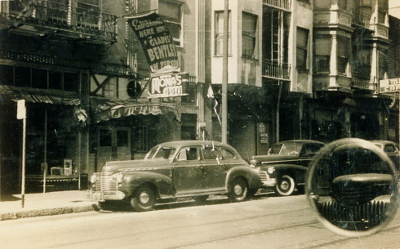
Photo courtesy of (Wide Open Town History Project Records 2003-05), Gay, Lesbian, Bisexual, Transgender Historical Society.
As the field of gay and lesbian studies first began to take shape in the 1980s, writer and activist Dennis Altman called attention to the central role that commercial enterprises played in the development of LGBTQ communities. “One of the ironies of American capitalism,” he observed, “is that it has been a major force in creating and maintaining a sense of identity among homosexuals.” While other minority groups depended on home and religious institutions to support their social and cultural practices, Altman observed that “for homosexuals, bars and discos play the role performed for other groups by family and church.”[1] As numerous historians have since demonstrated, LGBTQ communities first coalesced and became visible to themselves and the larger society in the early twentieth century largely in bars, rent parties, diners, bathhouses, and other commercial establishments.[2] Read more » [PDF 2.7 MB]
[1] Dennis Altman, The Homosexualization of America: The Americanization of the Homosexual (New York: St. Martin’s Press, 1982), 21.
[2] See Nan Alamilla Boyd, Wide-Open Town: A History of Queer San Francisco to 1965 (Berkeley: University of California Press, 2003); George Chauncey, Gay New York: Gender, Urban Culture, and the Makings of the Gay Male World, 1890-1940 (New York: Basic Books, 1994); and Elizabeth Lapovsky Kennedy and Madeline D. Davis, Boots of Leather, Slippers of Gold: The History of a Lesbian Community (New York: Routledge, 1993).
The views and conclusions contained in the essays are those of the authors and should not be interpreted as representing the opinions or policies of the U.S. Government. Mention of trade names or commercial products does not constitute their endorsement by the U.S. Government.
Part of a series of articles titled LGBTQ America: A Theme Study of Lesbian, Gay, Bisexual, Transgender, and Queer History.
Last updated: August 11, 2017
